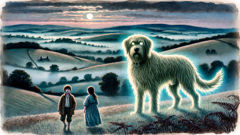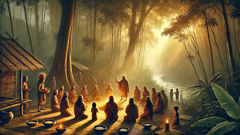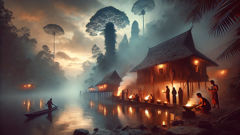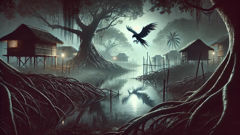Introduction
Hidden among the rolling emerald folds of Somerset’s Quantock Hills, a legend whispers its way through time. The countryside here is a patchwork of heather, bracken, and ancient woodlands, their boundaries blurring beneath the thick morning mist. Villages nestle like secrets at the feet of the hills, their stone cottages warmed by the smell of bread and peat fires. Yet even in daylight, the Quantocks carry an air of quiet enchantment, as if something gentle and unseen is always keeping watch. For centuries, parents and children alike have spoken in hushed but hopeful tones of the Gurt Dog—a great, spectral hound whose paws are said to make no sound and whose eyes shine with a light that calms the lost and comforts the frightened. Unlike the black dogs of other English legends, who bring ill omens and dread, the Gurt Dog is Somerset’s benevolent guardian. Children lost amid the tangled woods or lured too far by the call of the hills have claimed to feel a warm, shaggy presence by their side, nudging them gently back to familiar paths. Some say the Gurt Dog is as large as a pony, with a coat shimmering like moonlit water, and a tail that sweeps the dew from the bracken. Others recall the echo of a low, friendly bark in the darkness, moments before rescue. No one claims to own the Gurt Dog, nor to have summoned him; he simply appears when needed most, then vanishes into the folds of mist as quietly as he came. This is the story of how the Gurt Dog’s legend began—rooted in a single extraordinary summer, when the children of West Bagborough village discovered that the old tales carried more truth than anyone dared believe.
Whispers on the Wind
Long before the railway lines etched their way across Somerset and the world beyond seemed so close, the Quantock Hills kept their own company—sheltering deer in their hollows and foxes beneath their tangled roots. In the village of West Bagborough, children grew up listening to tales spun by grandmothers and shepherds about strange lights in the forest, willow wisps on the moors, and above all, the Gurt Dog. Most villagers treated these stories as gentle nonsense, meant to keep little ones from wandering too far. But to Anna Liddell and her younger brother Tom, the tales were a promise that adventure and comfort could be found at the very edge of the known world.
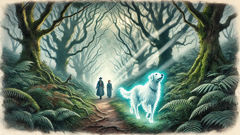
Anna was nearly twelve that summer, all wild curls and scraped knees, never happier than when she was clambering up Cothelstone Hill with Tom close behind. Tom was eight, quiet as a field mouse but just as curious, always trying to keep pace with his sister. Their mother worked at the inn, and their father tended sheep on the higher slopes, so Anna and Tom often spent whole days exploring, watched over only by the crows and the shifting clouds.
One afternoon, after a sudden summer storm, the woods felt different—deeper, almost alive with anticipation. Anna was sure she could hear voices in the wind, snatches of laughter and old songs echoing from glades thick with bluebells. Tom, clutching his wooden whistle, was less certain. "What if we see the Gurt Dog?" he asked, half in awe and half in dread. Anna, ever bold, grinned. "He only helps children who need him. Anyway, we know these woods better than anyone."
But the Quantocks have a way of turning familiar paths into mazes when the mists come down. As afternoon faded and the sky turned pewter, Anna and Tom realized they’d wandered farther than ever before. The trees grew closer together, their trunks twisting into strange shapes, and every direction seemed equally strange. Anna tried to lead them back to the ridge, but the mossy ground gave way underfoot and the air grew colder. Tom’s hand trembled in hers. She tried to sound brave—"We’ll be home for supper, you’ll see"—but worry crept into her voice.
Just as panic began to take root, a sudden hush fell over the forest. The wind dropped. Even the birds held their breath. Out of the drifting mist, a shape began to emerge—vast and shaggy, with fur as pale as morning frost and eyes that glowed like embers. Anna froze, heart hammering, but Tom squeezed her hand tighter. The hound approached, head low, tail wagging gently. There was nothing menacing in his manner; instead, an immense peace settled over the clearing. The Gurt Dog nudged Anna’s shoulder, then turned and padded along a barely visible path through bracken and ferns. The children followed, guided by the hound’s steady presence, until familiar trees and the far-off sound of the church bell brought hope flooding back.
By the time Anna and Tom reached the first sheep pastures, the mist had lifted and the Gurt Dog was gone—vanished as if he’d never been. All that remained was the memory of warmth and safety. When they stumbled into their mother’s arms that evening, muddy but unharmed, Anna tried to explain what had happened. Her mother listened closely, nodding as if she’d heard such stories before. "He’s an old friend to these hills," she murmured, smoothing Anna’s hair. "You must have needed him more than you knew."
Word spread quickly through West Bagborough that the Gurt Dog had been seen again. Children whispered excitedly, hoping for their own glimpse of the spectral guardian. Some grown-ups smiled indulgently; others, especially those who’d known hardship or loss, touched the charms they wore around their necks and looked to the hills with newfound respect.
The Night of the Lost Ones
As summer deepened, life in the village carried on much as before. Hay was cut and stacked, apples ripened in the orchard, and the hills shimmered beneath an endless sky. But beneath the rhythm of everyday chores, children felt a new thrill—an electric hope that they too might meet the Gurt Dog if ever they strayed or stumbled. The legend, once half-forgotten, now seemed almost close enough to touch.
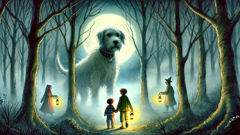
Anna and Tom became minor celebrities among their friends. At dusk, they would gather by the old yew in the churchyard and recount their adventure in breathless detail. Some claimed to have seen ghostly paw prints along muddy tracks or to have heard the soft padding of unseen feet outside their windows at night. Adults smiled and shook their heads. Yet even they began to notice how, in moments of trouble, the hills seemed to offer up small kindnesses—a sudden break in the fog, a guiding robin, or a found child safe and sound after a night away.
One evening, as July’s heat gave way to the cool promise of rain, trouble struck the village in earnest. The Thatcher twins—Eli and Maisie, both six and as mischievous as fox cubs—failed to return after an afternoon spent gathering wild strawberries. Their father searched the fields until nightfall, shouting their names into the gathering gloom. The village turned out with lanterns and dogs, scouring the hills, but the night grew thick with fog, and every tree seemed to hide secrets.
Anna could not sleep. She remembered her own fear in the woods—the way the Gurt Dog’s presence had changed terror into wonder. Against her mother’s protests, she crept out into the darkness, Tom close behind. The air was heavy with anticipation. Somewhere, a barn owl called. The siblings followed a path familiar from their own ordeal, hearts pounding, whispering for Eli and Maisie.
Suddenly, through the shrouded trees, they glimpsed a faint glow—not lantern light, but something softer, almost silver. There stood the Gurt Dog, as real and immense as Anna remembered, his fur sparkling with dew and his eyes gentle but urgent. At his side, two tiny figures clung to his flanks—Eli and Maisie, muddy but unharmed, gazing at their rescuers with wide eyes.
The hound stood still until Anna and Tom had gathered the twins into their arms. Then, with a deep, contented sigh, he padded away into the mists, his shape blurring and fading until only the echo of his presence remained. Anna knew then that the Gurt Dog was not just her own secret comfort, but a protector to all who needed him most.
By dawn, the story had spread across West Bagborough. The Thatcher twins’ rescue was celebrated as nothing short of miraculous. Villagers who’d doubted now found themselves peering into the woods with cautious hope. Some brought gifts to the foot of Cothelstone Hill—bread, cheese, or flowers—left as thanks for the unseen guardian. Others recalled old stories of similar rescues long ago, as if the Gurt Dog’s watch had never truly ended.
That summer marked a turning point for the village. Children learned to respect the hills’ mysteries but felt less afraid. Adults, too, found comfort in believing that some gentle force watched over their loved ones. The Quantocks seemed richer and more alive—a place where ordinary lives and ancient wonder intertwined.
A Legacy Woven in Mist
Years passed, but the legend of the Gurt Dog only grew stronger. Every child in West Bagborough, and soon in villages all across the Quantocks, learned to look for glimmers of silver among the bracken. Parents told new stories at firesides—of the hound who could not be leashed or tamed, but who always answered the call of those in need.
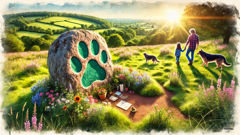
Anna and Tom grew older, their days of wild wandering slowly replaced by the duties of farm and family. Yet the hills remained their touchstone—a living memory of safety, magic, and belonging. Anna became a teacher at the village school. On stormy afternoons, when wind rattled the windows and the world felt too big or too frightening for her pupils, she would gather them close and share her own story of rescue. Her words, alive with detail, always ended the same way: “The Gurt Dog comes when you least expect him—and always just in time.”
Tom, meanwhile, became a shepherd like his father. He spent long, silent hours alone among the hills, learning every dip and rise of the land. Some evenings, as dusk fell and the sky shifted from gold to violet, he would pause at the edge of a wood and listen for the soft pad of paws or a low, friendly bark. He never saw the Gurt Dog again as clearly as that first time, but sometimes a feeling—warmth against the cold, or an inexplicable sense of direction—guided him safely home.
The legend spread beyond West Bagborough. Travellers, lost in the fog or caught by sudden storms, told of meeting a great dog who led them back to safety. Shepherds claimed their flocks were protected from harm when the hound’s shape passed through moonlit fields. In time, stories merged and shifted: some said the Gurt Dog had once been a real animal whose spirit refused to leave his beloved hills; others believed he was a guardian spirit called forth by ancient spells or the prayers of worried mothers.
Yet always, the core remained unchanged—a benevolent, shaggy hound who offered hope without asking anything in return. He became a symbol for all that was kind and constant in a world that could seem wild or indifferent. Children wore small charms carved in his likeness; a stone near Cothelstone Hill bore his pawprint, placed there by villagers who wished to keep his memory alive.
Even as times changed—railways came, fields were enclosed, and new faces arrived in the valley—the Gurt Dog endured. His legend gave comfort to lonely wanderers and mischief-makers alike. On misty mornings, when the hills seemed to float between worlds, parents would smile and tell their children to listen for a bark carried on the wind or to watch for silver fur gleaming between the trees.
For Anna and Tom, now grown and with children of their own, the hills remained a place where magic felt possible. Sometimes, walking together beneath ancient oaks, they would pause and remember the night they’d been guided home—not just by a story, but by something loving and real, woven forever into the heart of Somerset.
Conclusion
The legend of the Gurt Dog remains stitched into the very fabric of Somerset’s Quantock Hills—a gentle tale passed from generation to generation, richer for each telling. Long after Anna and Tom’s time, new children continued to wander the wild paths, certain that some kindly presence watched their steps. The Gurt Dog became more than a story; he became a promise that even in the loneliest moments, no one was ever truly lost or alone. His legend endures not just in whispered words or carved stones, but in every act of kindness shared beneath those ancient trees. When fog drifts low across the heather, and a soft breeze stirs the bracken, you might still sense him near—a fleeting shadow, a reassuring nudge, or simply the warmth of hope guiding you home. In this way, Somerset’s spectral guardian lives on, both real and imagined, as faithful as the hills themselves.

